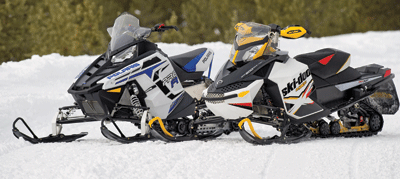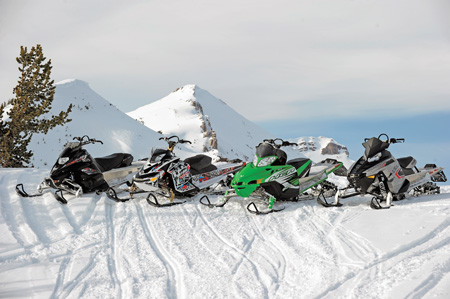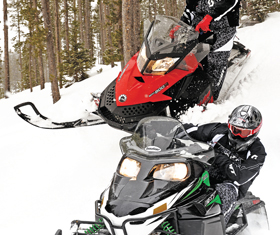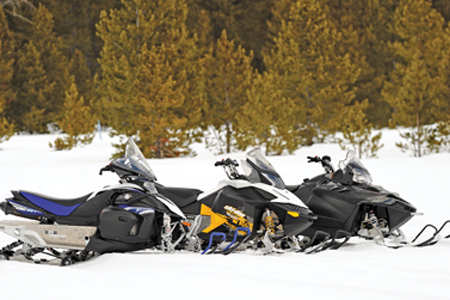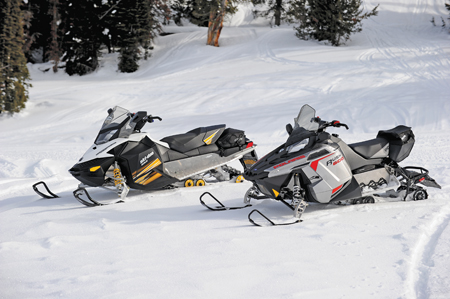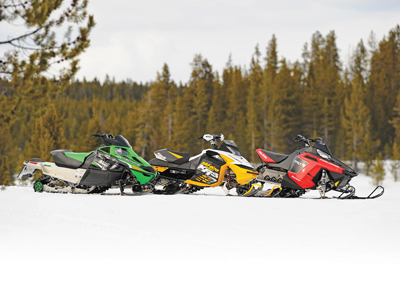2011 Utility Snowmobile Comparison
 Paul Bunyan never backed away from a day of cold, hard work. The fabled lumberjack felled entire forests in one swing by tying his axe to a long rope. When his titanic blue ox Babe needed a water dish, he dug the Great Lakes. Together they created Oregon’s Mount Hood by piling up rocks to snuff out a campfire and, on another occasion, Paul and Babe dug the mighty Grand Canyon by dragging an axe. They knew raw power and the right tools could enable them to accomplish anything, and the same is true for us mortals — on a slightly lesser scale.
Paul Bunyan never backed away from a day of cold, hard work. The fabled lumberjack felled entire forests in one swing by tying his axe to a long rope. When his titanic blue ox Babe needed a water dish, he dug the Great Lakes. Together they created Oregon’s Mount Hood by piling up rocks to snuff out a campfire and, on another occasion, Paul and Babe dug the mighty Grand Canyon by dragging an axe. They knew raw power and the right tools could enable them to accomplish anything, and the same is true for us mortals — on a slightly lesser scale.
A dedicated Snowbelt resident, Bunyan also liked to play in the snow. He and his seven-man crew (all named Elmer, for brevity’s sake) loved to ride old-time, horse-driven snowmobiles on weekends. In fact, his favorite trail later became memorialized as Alaska’s 1,900-mile Iron Dog race.
Today’s alpine lumberjacks have chainsaws, Gore-Tex, 90,000-pound skidders and advanced snowmobiles for reaching the most godforsaken areas. The results can be as impressive as Paul’s, but the job may take a bit longer than legend suggests.
Wearing heavy boots, breathable gear and a bit of flannel thrown in for nostalgia, our four-man crew of neo-woodsmen loaded up tools, tow ropes, notebooks and cameras to put four very different 2011 utility sleds to the test — Yamaha’s VK Professional, the Ski-Doo Tundra Xtreme, Arctic Cat’s Bearcat Z1 XT and the Polaris 500 Widetrak LX. Each offered a unique take on the utility market, with the VK serving traditional high-end utility needs, the Tundra Xtreme leaning toward backcountry exploration, the Widetrak offering utility on a budget and the Bearcat featuring touring amenities.
With infinite off-trail acreage in every direction, team lead John Prusak, managing lumberman Andy Swanson, contributing feller Jeff Oberg and myself, a humble cutter, drove our sled-steers into the Montana wild. The goal of the operation was to run well-made trails, do some backcountry boondocking and clear a few blown-down trees.
Calked Boots and Cant Hooks
Our most experienced piece of equipment was the Polaris Widetrak LX, whose platform debuted in its current form in 1999. At $8,799, it is the most affordable of the sleds, with a 500-class two-stroke twin powerplant offering a sound, look and character that recalls sleds from a time gone by. It’s a stout rig, with a long, flat seat, cargo racks, low range and a 20-inch track for flotation.
Nineteen hundred dollars up the totem pole, the all-new Ski-Doo Tundra Xtreme looks the sportiest, lists for $10,699 and is the smallest sled by its dimensions, especially width. Built on the REV-XU platform, the Tundra Xtreme has Doo’s unusual inboard “Lynx telescopic” front suspension keeping things narrow and stressing durability, with a long cargo rack behind a small, one-man seat.
Yamaha’s RS Viking Professional looks the most utilitarian with a large, removable rear seat, cavernous under-seat storage, a rear tow hitch, a hulking four-stroke, three-cylinder engine, low range, an ultra-rigid chassis, a rear rack, 20-inch track and an $11,499 price tag.
Built on an extended Twin Spar chassis, the Arctic Cat Bearcat Z1 XT is the most elephantine, most expensive and it looks tough, more like a traditional 2-Up sled with a lengthy rear rack behind the passenger seat and broad 8-inch skis. It lists for $11,999 — that’s a lot of flapjacks!
Axe Men
With eager riders and four diverse sleds, we left camp for the wooded mountains outside West Yellowstone, Montana. Our first job was testing the limits of our equipment in virgin snow. We hung a sharp right turn off the trail and into the backcountry. Feet of snow provided myriad untouched paths that wound through the pines, an ideal test ground for flotation, traction and deep-snow maneuverability.
Next, we cooled off with some easy trail riding. While each rig can cruise down a trail, impressions varied regarding the poky Polaris, slim Ski-Doo, stump-yanking Yamaha and satisfying Arctic Cat.
For the main event, we again headed into the woods, this time venturing down a steep hill to a valley that’s frequented by riders looking to play around off-trail. Many downed trees lined the forest’s edge, and we used our steeds to spruce up the valley and clear some dead timber. Pulling, or trying to pull, huge logs stressed the machines, tested the tensile strength of our tow straps and separated the men from the boys.
2011 Polaris Widetrak LX:
The Ranch Hand

Park your caboose on the Polaris and one thing is readily apparent: this machine is a living relic from the 1990s, when it migrated to the Gen II chassis — complete with a trailing arm front end, which was great at the time but now looks archaic. Switchgear and materials quality will remind you of a simpler time of total two-stroke dominance and machines with basic, less flashy appointments. As this is an affordable work sled, not a luxury cruiser, no deals have yet been broken.
On paper, the 488cc, liquid-cooled, two-stroke twin appears somewhat strapping, but it sounds strained at all speeds — acting more like a fan-cooled sled at the altitude of our tests. Down the trail, we struggled to hit 55 mph, and the engine sounds like it’s being worked hard. Also, its disappointing turning radius drew comparisons to logging trucks — something we really noticed when picking our way through tight trees off trail. This sled is no athlete, but is fully capable of plowing through deep snow.
An adjustable backrest allows the Widetrak to convert between one- or two-person duties, and a large under-seat storage bin and the steel rear rack should be able to haul a midsize cooler, a chainsaw or a hefty handful of split firewood. A monstrous windshield blocks any breezes this underpowered buggy can stir up.
When it came time to get our hands dirty and drag some logs, the Polaris was only more brawny than the smallest Ski-Doo. The tow-test results backed this up, as it could pull small logs, but was foiled by the big stuff — not enough power, traction or mass for serious dragging.
Our crew concluded this machine was best used in situations where maneuverability, high speeds and serious grunt work are not required. Even so, it’s very capable, stable, has plenty of storage, is the least expensive by a country mile and would be a great laborer at alpine resorts or on the sprawling grounds of a ranch.
Summing it up, Oberg said, “Based on looks alone, I felt like I was on a vintage ride.”
2011 Ski-Doo Tundra xtreme:
The Boondocker

Fresh off the train for 2011, the new Tundra Xtreme rides on the REV-XU chassis and looks like the modern sled it is – sort of. The familiar Rotax E-TEC 600 H.O. resides under-hood and provides plenty of get-up-and-go for silly fun in deep snow and trail riding. At 495 pound dry, it drives light and feels small, because it’s the least portly sled in the group.
Off-trail riding was thrilling, with ergonomics that encourage drivers to stand up and manhandle this playful sled through the trees. One tester declared the Tundra to be the “most maneuverable sled I have ever driven in my life” and said if it was never taken on the trail, you could weld the handlebars straight and steer by effortlessly leaning your body weight into turns.
Trail riding the Tundra was unusual. The avant-garde, strut-based front-end with an ultra-narrow, 32-inch stance allows a lot of wallowing and tipping when cornering at speed, suggesting the driver should exercise caution when changing directions. The rear suspension absorbs bumps much like any other mid-size Ski-Doo for a compliant, predictable ride — provided you’re heading in a straight line.
Even our inexperienced lumbermen knew the Tundra is not meant for pulling logs. That doesn’t mean we didn’t give it a try, but wildly spinning the track with a log tied to the back end didn’t change our initial hypothesis. This is no tree hauler.
There’s no under-seat storage like the others, but the pint-sized Doo has a massive rear rack that could haul a lot of goodies to make up for it. We’d suggest hauling some lunch and beverages for a full day’s boondocking ride, because this machine will blow you away with its control, light weight and power off the trail. It’s designed for flotation and getting the driver into areas other sleds can’t go – but, once you’re there, expect to do any planned work yourself.
“So much fun, so quick and incredibly nimble through the trees, this specialized little rig is one of the most unique sleds in snowmobiling,” read one enraptured notebook.
2011 Yamaha RS Viking Professional:
The Hard Worker

The long, wide, heavy RS Viking Professional is a beast of a sled if there ever was one. It’s powered by a torque-heavy 973cc four-stroke triple, but almost sounds like a piece of diesel equipment — very muscular and very heavy-duty. We expected the robust Viking to be the king of the log-pulling contest, and our suspicions were dead-on.
Its capabilities as a worker are clear: direct-to-crankshaft clutching instead of gear reduction, a 1.25-inch Camoplast Rip Saw track, low range, Deltabox chassis, independent front suspension with 9 inches of travel, large skis, big under-seat storage, a smallish rear rack and room for a passenger, with a spacious rear seat.
Over deep snow while playing around in the woods, this tanker performed surprisingly well with good flotation front and back and smooth power that could be carefully regulated with the throttle to avoid getting stuck. Many snowmobilers use such wide, heavy sleds for backcountry riding and, while it may seem antithetical by the guys who say “lighter is better” in powder, the Viking will take you where you need to go — almost no matter what.
Pulling downed trees with this sled was the highlight of our day, or week depending on whom you ask. It might take a few tugs back and forth, but the big Yamaha was able to unearth massive, frozen-in trees with its copious low-end torque. We may have been carried away, as we were compelled to try and pull consecutively larger logs until we found the limit — resulting in one heavy, buried snowmobile. As my Great Grandfather Jack Morrison, a real-life lumberjack, used to say when the going got tough: “We’re logging now!” For whatever it’s worth, we left western Montana forests a cleaner, more organized place.
High, reverse and low ranges are engaged with an industrial-feeling lever to the right of the fuel tank, but we would’ve appreciated a sticker telling riders what gear the transmission is in. The under-seat storage isn’t as big as the Arctic Cat, but it’s still very useful. And, the windshield is massive, which is appreciated even if the plastic distorts the view. Solid build quality reassures riders it’s OK to work it to the bone.
Riding the groomed trails at 7,00-plus feet, the Viking approached 75 mph on straight stretches, and felt stable at all speeds — almost freight train stable — with a touch of body roll. The peanut gallery agreed this is a great heavy-duty snow truck, and is comfortable enough for extended 2-Up touring. Heated passenger grips are a nice touch.
“If you’re primarily looking for a tough-as-nails work sled, but still may occasionally venture out on the trails, the Yamaha has the power, storage and features for the job,” one rider said.
2011 Arctic Cat Bearcat Z1 XT:
The Big, Tough Cruiser

One tester admitted feeling the king-sized, clearly heavy Bearcat Z1 XT would be a handful on the trail with massive skis that looked “like only Popeye could turn them,” but he was wrong. Notes included surprised riders expressing shock that such a big sled could be such a delightful trail rider.
“Wow! What a pleasure to drive on the trail,” Swanson said. “So big, heavy and planted that I feel safe and secure, protected by the big windshield that will keep me warm.”
Heading off trail, the Bearcat held its own and provided similar levels of flotation, traction and steering abilities as the Viking. Power from the Z1 four-stroke was adequate at all but the top end of the power band. Push-button reverse was user-friendlier than levers on the Yamaha or Polaris, and we made it through thick woods without incident.
In the pulling contest, it was neck and neck between the Arctic Cat and Yamaha — with the Yamaha taking the cake for its low range, which was conspicuously absent on the Cat. Even without it, we were awed by the size of logs it could pull. Hard work is no challenge for the Bearcat, even if it isn’t its greatest asset.
With mirrors (which felt flimsy), a very comfortable, removable rear seat that keeps driver and passenger separated, a big rear rack and the largest under-seat storage, our band of faux loggers felt the Bearcat was the ultimate two-person touring machine.
Straight trails allowed us to briefly surpass 65 mph at altitude, and its predictable handling, plush rear suspension, pleasant engine, comfortable seats, ample room and precise turning made for an effortless drive — like piloting a Lincoln Town Car down the freeway.
“This is a great balance between two-person snow limo and backcountry workhorse,” came out of the author’s notebook. “I like everything about this sled — one of Cat’s very best.”

